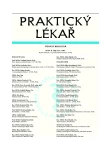Occupational meningitis caused by Streptococcus suis
Authors:
K. Boušová 1; Z. Hermanová 2
Authors‘ workplace:
Lékařská fakulta Univerzity Karlovy a Fakultní nemocnice v Hradci Králové, 1Klinika nemocí z povolání, Přednosta: doc. MUDr. Jiří Chaloupka, CSc., 2Klinika infekčních nemocí, Přednosta: MUDr. Stanislav Plíšek, Ph. D.
Published in:
Prakt. Lék. 2010; 90(7): 430-433
Category:
Case Report
Overview
The bacterium Streptococcus suis is a common pathogen in pigs worldwide. It is responsible for a range of diseases in pigs and causes large economic losses in livestock production annually. Individuals that come into contact with sick or infected animals are at risk: primarily pig breeders, veterinarians, vet technicians, butchers and other workers engaged in raw pork processing. Most of these cases are therefore classified as occupational diseases. The bacterium enters the body through a cut/wounds or lesions of the skin or mucosa of the mouth and nasal cavity; infection through intact oropharyngeal mucosa is less common. The disease usually manifests itself clinically as meningitis (septicaemia, pneumonia or endocarditis are rare). The development of toxic shock syndrome is connected with a high mortality rate (overall average of 17 % throughout the world). 75 % of patients with meningitis suffer from permanent hearing loss and vestibular dysfunction. Precise diagnosis of the aetiologic agent is necessary for successful treatment. The most commonly isolated S. suis serotype, type 2, is generally sensitive to penicillin, ampicillin, 2nd and 3rd generation cephalosporins and cotrimoxazol.
The article describes an isolated case of purulent meningitis in the Czech Republic in a young woman working as a pig keeper. The development of audio-vestibular disorder after the acute phase passed led to permanent disability in this patient. Infections caused by S. suis must be taken into account in cases of septicaemia with meningitis in adults with a history of previous contact with pigs or uncooked/undercooked pork. The most important prevention measure against the occurrence of this infection is on-going and responsible personal protection of individuals in risk environments.
Key words:
Streptococcus suis, purulent meningitis, occupational diseases, occupational anthropozoonoses.
Sources
1. Bardoň, J., Čížek, A. Zoonotický význam vybraných druhů grampozitivních bakterií. Klin. mikrobiol. Inf. Lék 2006, 12, 1, s. 10-12.
2. Braun, S., Jechart, G., Emmerling, U., Ehret, W. Meningitis caused by Streptococcus suis. Dtsch. Med. Wochenschr. 2007, 132(20), s. 1098-1100.
3. Brhel, P., Petrovová, M. K problematice profesionálních přenosných a parazitárních nemocí. Pracov. Lék. 2009, 61(2), s. 63-68.
4. Dragojlović, J., Milosević, B., Sasić, N. et al. Streptococcus suis infection-clinical manifestations. Med. Pregl. 2005, 58(5-6), p. 236-239.
5. Dubanský, V., Drábek, J. Klinické příznaky a neobvyklé průběhy S. suis infekcí u lidí. Veterinářství 2006, 56, s. 44-50.
6. Fenclová, Z., Urban, P., Pelclová, D., Lebedová, J. Profesionální onemocnění hlášená v České republice v roce 2008. České pracov. lék. 2009, 10(2), s. 62-70.
7. Fenclová, Z., Urban, P., Pelclová, D., Lebedová, J. Profesionální onemocnění hlášená v České republice v roce 2007. České pracov. lék. 2008, 9(2-3), s. 72-80.
8. Fenclová, Z., Urban, P., Pelclová, D., Lebedová, J. Profesionální onemocnění hlášená v České republice v roce 2006. České pracov. lék., 2007; 8(2), s. 72-81.
9. Fenclová, Z., Urban, P., Pelclová, D. a kol. Profesionální onemocnění hlášená v České republice v roce 2005. České pracov. lék. 2006, 7(2), s. 60-68.
10. Haleis, A., Alfa, M., Gottschalk, M. et al. Meniningitis caused by Streptococcus suis serotype 14, North America. Emerg. Infect. Dis. 2009, 15(2), p. 350-352.
11. Cheung, P.Y., Lo, K.L., Cheung, T.T. et al. Streptococcus suis in retail markets: how prevalent is it in raw pork? Int. J. Food. Microbiol. 2008, 127(3), p. 316-320.
12. Kennedy, K.J., Jadeer, A.A., Ong, C.W. et al. Two cases of Streptococcus suis endocarditis in Australian piggery workers. Med. J. Aust. 2008, 189(7), p. 413.
13. Kersting, A.L., Medeiros, L.C., LeJeune, J.T. Zoonoses and the physicians’ role in educating farming patients. J. Agromedicine 2009, 14(3), p. 306-311.
14. Lun, Z.R., Wang, Q.P., Chen, X.G. et al. Streptococcus suis: an emerging zoonotic pathogen. Lancet Infect. Dis. 2007, 7(3), p. 201-209.
15. Manzin, A., Palmieri, C., Serra, C. et al. Streptococcus suis meningitis without history of animal contact, Italy. Emerg. Infect. Dis. 2008, 14(12), p. 1946-1948.
16. Rusmeechan, S., Sribusara, P. Streptococcus suis meningitis: the newest serious infectious disease. J. Med. Assoc. Thai. 2008, 91(5), p. 654-658.
17. Smith, T.C., Capuano, A.W., Boese. B. et al. Exposure to Streptococcus suis among US swine workers. Emerg. Infect. Dis. 2008, 14(12), p. 1925-1927.
18. Tang, J., Wang, C., Feng, Y. et. al. Streptococcal toxic shock syndrome caused by Streptococcus suis serotype 2. PLoS Med. 2006, 3(5): e 151.
19. Tramontana, A.R., Graham, M., Sinickas, V., Bak, N. An Australian case of Streptococcus suis toxic shock syndrome associated with occupational exposure to animal carcasses. Med. J. Aust. 2008, 188(9), p. 538-539.
20. Wangsomboonsiri, W., Luksananun, T., Saksornchai, S. et al. Streptococcus suis infection and risk factors for mortality. J. Infect. 2008, 57(5), p. 392-396.
21. Wertheim, H.F., Nghia, H.D., Taylor, W., Schultsz, C. Streptococcus suis: an emerging human pathogen. Clin. Infect. Dis. 2009, 48(5), p. 617-625.
Labels
General practitioner for children and adolescents General practitioner for adultsArticle was published in
General Practitioner

2010 Issue 7
- Metamizole vs. Tramadol in Postoperative Analgesia
- What Effect Can Be Expected from Limosilactobacillus reuteri in Mucositis and Peri-Implantitis?
- Metamizole at a Glance and in Practice – Effective Non-Opioid Analgesic for All Ages
- Memantine in Dementia Therapy – Current Findings and Possible Future Applications
Most read in this issue
- Strabismus surgery in adults – yes or no?
- Liver transplantation in children
- Atrial fibrillation and electrical cardioversion in the outpatient cardiology department
- Asplenic patient – responsibility of all of us
